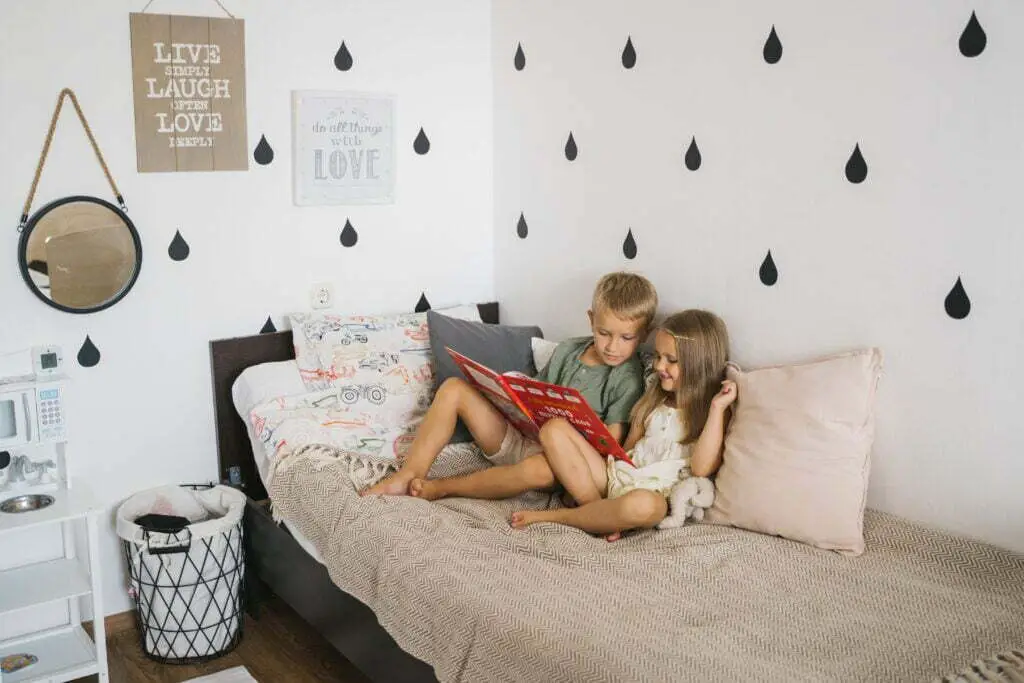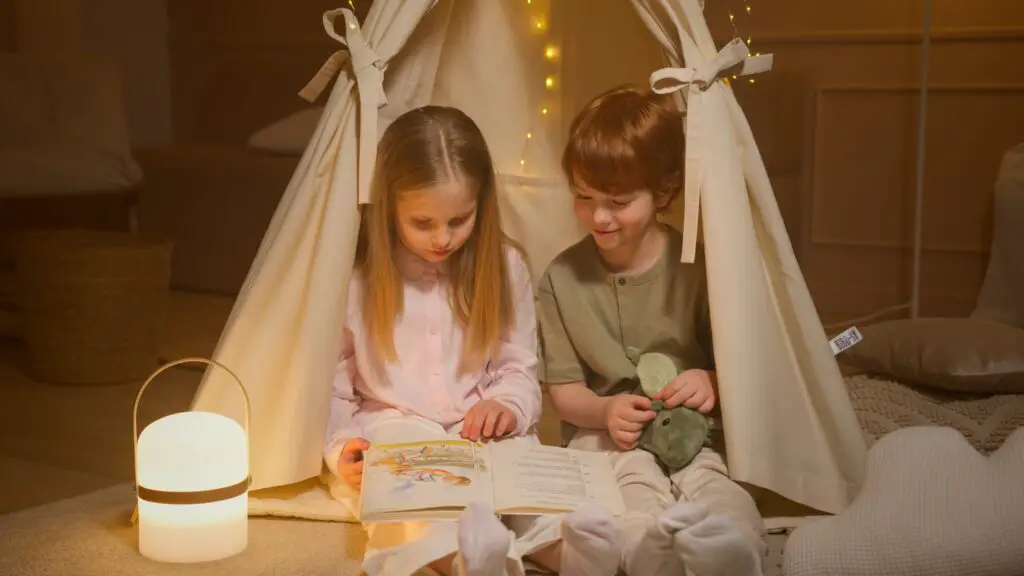“Ever wondered how to ace the art of Sibling Room Sharing Hacks?
From clever shared spaces for kids to nifty bedroom organization tricks and sibling bonding games, we’re about to dive deep and give you Parenting Hacks and Tips!
Navigating this shared bedroom journey isn’t just about room setups; it’s a blend of laughter, whispered secrets, and the occasional pillow fight.
Let’s journey together into creating that perfect blend of harmony and fun!”

Some of the links in this post are affiliate links. This means if you click on the link and purchase the item, I will receive an affiliate commision at no extra cost to you. All opinions remain my own. Read more on our Privacy Policy Page
Understanding the Benefits and Challenges
Navigating the world of a shared sibling bedroom can be like setting sail on a vast ocean. There are serene moments of camaraderie and rough patches of conflict. But to traverse this ocean effectively, understanding the nuances, the benefits, and challenges, is paramount. So let’s dive deeper.
BENEFITS of shared sibling bedroom
Bonding Time
Sharing a bedroom can bolster the bond between siblings, offering endless hours of playtime and companionship.
Shared Responsibilities
Children learn the value of responsibility by keeping their shared space tidy and respecting each other’s belongings.
Problem-Solving Skills
Disagreements are inevitable, but they also offer a chance to develop negotiation skills.
Emotional Growth and Resilience
Sharing a room often means sharing emotions. Siblings become each other’s confidants, supporting each other during challenging times. This emotional closeness fosters resilience, as they always have a buddy to lean on.
Teaching Moments Galore
With two or more personalities in one room, there are bound to be disagreements. These situations, while challenging, are also prime teaching moments. Children learn about compromise, empathy, and understanding, skills that will benefit them in the broader world.
Cost Efficiency
Let’s not forget the practical side of things. Two in one room means fewer rooms to heat, light up, or cool down. It’s a win-win situation for parents looking to save on utility bills.
Lesser Loneliness
Night-time fears or simply feeling alone can be daunting for a child. Having a sibling in the same room can provide reassurance, making those dark nights a bit more bearable.
AMAZING KIDS BEDROOM DECOR >>> CHECK OUT NOW on amazon!
CHALLENGES of shared sibling bedroom

Differing Schedules
One might be a night owl while the other’s an early bird.
Personal Space Issues
As kids grow, their need for personal space may increase, potentially leading to conflicts.
Differing Interests
One might love dinosaurs, and the other, unicorns. Finding a middle ground can be tough.
Differing Personalities
Sometimes, opposites don’t attract. An introverted child might struggle to share space with an extroverted sibling, leading to friction. Recognizing and understanding these inherent differences is vital.
Age Gap Issues
When there’s a significant age gap, the younger child’s toys or the elder one’s study books might get in the other’s way. The younger one might want to play while the older one needs silence for studying.
Less Independence
For kids yearning for a personal touch, a shared room might feel restrictive. They may feel they don’t have the freedom to be themselves fully, leading to feelings of being ‘trapped’.
Managing Different Routines
If one child has soccer practice early in the morning while the other practices the violin late at night, syncing their routines can be a logistical challenge.

A shared sibling bedroom is a dynamic environment. It’s a space that sees laughter, tears, growth, and evolution. While the challenges might seem daunting, with understanding and patience, they can transform into opportunities for growth. After all, the goal isn’t to create a picture-perfect room, but to foster a relationship that stands the test of time
Making the Most of Sibling Sharing Bedroom Together
Living together in a shared space is both an art and a science. The confined quarters of a sibling bedroom test the waters of patience, creativity, and adaptability. Let’s delve into each strategy to truly harness the potential of a shared sibling bedroom.
1. Equal Space
The Foundation of Fairness:
Every child, no matter their age, seeks a sense of belonging and equity. By demarcating equal spaces for each sibling, parents lay the foundation of fairness. This might mean splitting the wardrobe down the middle, having twin beds of the same size, or giving each child an equal-sized drawer. This very act sets a subconscious understanding: “We are equal in this shared journey.”
Avoiding Power Struggles:
When spaces are designated equally, it reduces room for potential territorial disputes. There’s no ‘larger side’ or ‘better shelf’, just a harmonious co-existence.
2. Zone the Room
The Power of Personalized Corners:
Zoning is more than just about organization; it’s about identity. By creating distinct zones for sleeping, playing, and studying, children can have micro-environments tailored to their unique needs and personalities.
Fluidity and Flexibility:
With time, needs change. Maybe the study zone transforms into a hobby corner. The beauty of zones is they can evolve, mirroring the growth of the children.
3. Invest in Quality Furniture
Long-Term Benefits:
While upfront costs might seem high, investing in good-quality, durable furniture can be economical in the long run. Imagine a bed that converts from a toddler bed to a teen’s daybed, or a desk that adjusts its height as your child grows.
Check on amazon!>>>TARTOP Twin Over Twin Size Low Bunk Beds with roof and Fence

Safety First:
Quality furniture also ensures safety. No wobbly bunk beds or chairs that might give way. It’s a silent promise of security.
CHECK OUT!>>>Baoniu Foldable Climbing Triangle Ladder Toys with Ramp for Sliding or Climbing

4. Incorporate Individuality
A Canvas of Expression:
A shared sibling bedroom needn’t be a monotonous, uniform space. Letting each child pick their wall color, bedding, or posters allows them to imprint their essence onto the canvas of the room.
Balancing Unity and Individuality:
While personal choices dominate, finding common ground (maybe a shared lamp or rug) can subtly remind them of their united journey, amidst the individual paths.
5. Establish Rules
The Pillars of Coexistence:
Rules aren’t about stifling freedom but laying the pillars of peaceful coexistence. It could be as simple as ‘No loud music after 9 PM’ or ‘Always knock before entering’.
Fostering Respect:
By adhering to rules, siblings cultivate respect, not just for the shared space but for each other’s boundaries and feelings.
6. Rotate Chores
Shared Spaces, Shared Responsibilities:
Rotating chores avoids the pitfalls of one sibling feeling overburdened. This week’s bed-maker might be next week’s desk-cleaner.
Teaching Accountability:
This routine instills a sense of responsibility. It’s a lesson that says, “This is our space, and we’re both responsible for keeping it vibrant and tidy.”
A shared sibling bedroom isn’t merely a room with two beds. It’s a microcosm of life, teaching lessons of shared responsibilities, mutual respect, individuality amidst unity, and adaptability. As parents, facilitating this environment becomes a journey of understanding and evolving alongside the children.

Finding Solutions to Potential Problems
The realm of a shared sibling bedroom, while filled with laughter and cherished memories, is also peppered with challenges. However, every problem presents an opportunity for growth, understanding, and creativity. Here’s a deeper dive into the potential issues and their solutions.
1. Dealing with Different Sleep Schedules
Understanding Biological Clocks:
Every child, like adults, has an internal clock, also known as the circadian rhythm. Some kids are naturally predisposed to stay up late, while others are early birds. Recognizing this can help parents understand and cater to each child’s needs better.
Creating Mini Sanctuaries:
For siblings with drastically different schedules, consider using room dividers or even canopies around beds. These provide a semblance of privacy and can help create a ‘mini room’ feeling. This way, one child can read under a light without disturbing the other’s sleep.
Consistent Routine Development:
While respecting individual rhythms, try to establish a semi-consistent bedtime routine. Over time, this can synchronize sleep patterns or at least bring them closer.
2. Personal Space Invasion
The Need for a Safe Haven:
Even within shared spaces, everyone needs a ‘safe haven’ – a space untouched by anyone else. This could be a special drawer, a shelf, or even a small box of personal treasures.
The Magic of Boundaries:
Educate the siblings about boundaries. Using fun tactics like ‘do not cross’ lines or ‘magic circles’ can make the learning process enjoyable. Understanding and respecting boundaries in a room translates to respecting boundaries in life.
Open Conversations:
Encourage open conversations about feelings. If one child feels their space is being invaded, creating a platform for them to express their concerns can prevent feelings of resentment.
3. When Interests Collide
Celebrate the Differences:
First and foremost, parents should acknowledge and celebrate the distinct interests of each child. Whether it’s dinosaurs versus fairies or space versus forests, these differences enrich the shared space.

Merging Worlds:
While each side of the room can represent each child’s interests, find creative ways to blend them. Maybe the space and forest theme can intertwine, with planets hanging over trees. It’s about crafting a storyline that merges their worlds.
Neutral Grounds:
If merging seems tough, opt for neutral themes for the larger room aspects like wall colors. Allow personalization through easily changeable decor items like posters, bedspreads, or toys.
Large Kids Tent, Kids Playhouse >>> CHECK OUT NOW on amazon!

Problem-solving as a Life Skill
Navigating the potential problems of a shared sibling bedroom is much more than ensuring a peaceful night’s sleep. It’s about imparting life lessons of understanding, compromise, respect, and creativity. When approached with empathy and innovation, these ‘problems’ transform into foundations for building strong sibling relationships and resilient individuals.
Final Thoughts
Having a shared sibling bedroom might pose some challenges, but with the right tips for parents, it can become a space of growth, bonding, and countless cherished memories. Remember, every challenge faced in that shared space is a lesson in patience, sharing, and love.
The journey may seem daunting, with its highs and lows. But with the right strategies, this shared space can become a treasure trove of memories, lessons, and growth for your little ones.
Now, it’s your move. Dive into this shared adventure with both feet. Embrace the challenges, celebrate the triumphs, and craft a shared sibling bedroom that’s more than just a space – it’s a story. Transform those four walls into a canvas of dreams and possibilities. And as you do, remember: every challenge is an opportunity in disguise.
So, are you ready to co-author this magical tale with your children?
references: https://www.parents.com/search?q=sharing+bedroom, https://www.aap.org/









